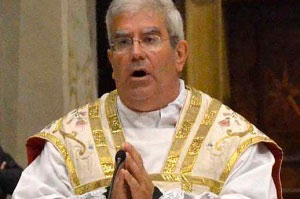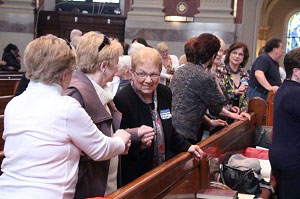

|
| Musical Musings: Liturgy |
|
|
The Sign of Peace Should be the Object of an Attentive Evaluation and VerificationAn Interview with Don Enrico Finotti
This article is reprinted from the 08 May 2020 issue of Altare Dei, with the kind permission of the founder and editor, Aurelio Porfiri.
Aurelio Porfiri: The coronavirus epidemic makes us more concerned about human relationships at close range. With regard to the Mass, this makes us reconsider the Sign of Peace, which to some now seems to have been emptied of its purpose. What do you think?
There are two different perspectives for understanding and carrying out the liturgical sign of peace:
Thus there are two aspects: the mutual peace that reconciled hearts exchange and the supernal peace that flows as the result of the divine Sacrifice, the peace that the world cannot give because it is the gift of the Risen One, according to his greeting: Pax vobis! Porfiri: This is all true, but doesn't it seem to you that nowadays more importance is given only to the horizontal dimension of the sign of peace as a gesture of friendship between people in which any reference to a divine gift that you mentioned is completely missing? Even the Congregation for Divine Worship tried in 2014 to place some sort of boundary in place so as to prevent the abuse of this liturgical gesture. Finotti: The Roman liturgical tradition favors the transcendent aspect of peace, which comes from on high and flows from the bloodless immolation of the Lord. This is why it locates the gesture in the context of the fractio panis before Communion. Thus the sacred character of the gesture is completely evident, both by the descending action whereby peace is communicated level by level from the priest to the higher ministers, then to the lower ministers, finally reaching the people, as well as by the highly sacred moment in which the sign of peace takes place, in immediate proximity tothe tremendous mysteries of the Body and Blood of Christ. In order to adequately carry out the Rite of Peace according to the classic Roman Liturgy, it is necessary to respect precise protocols that assure the sacred character of such a gesture, as well as its transcendence:
By following these guidelines rigorously the sign of peace may be maintained in its true sacred identity. Unfortunately, we see how distant the common practice today has becomefrom the liturgical model attested to over the centuries. We therefore need a serious and courageous effort to prevent any opportunity for the sign of peace to devolve into a free spontaneity on the part of the faithful. Porfiri: Exactly! This gesture has now lost the sacred sense that you are adorning it with. And what should we think today about extending our hands to perfect strangers after health recommendations have been made against this gesture because of the coronavirus pandemic? I would have serious difficulties shaking someone's hand knowing the great risks connected with doing so.
Porfiri: In effect, at least in this matter, I am firmly convinced that we must learn from the Chinese, who do not extend the hand but rather incline their heads to each other. Don't you think that this could be a solution that the Church could propose in order to continue this liturgical gesture while at the same time respecting health requirements? Finotti: No official norm is needed because there is already freedom to choose how to express the sign of peace. It is a question of introducing forms of expression that are compatible with common sense and liturgical propriety. The present calamity could be a propitious occasion for a reconsideration of the sign of peace and a correction of behavior. Porfiri: Do you think that the Italian Church is ripe for such changes in the liturgy, where ideology has tended to predominate? Finotti: Every ideology deforms the truth or at least reduces it, and so inevitably over time it will vanish. True edification and lasting homogeneous progress will come about only through a correct vision of the theological nature of the Sacred Liturgy and an objective knowledge of its historical development that is not separated from a mature obedience to the liturgical tradition of the Church. Therefore it is necessary to abandon every vision that is ideological and return to the authentic documents of the perennial Magisterium of the Church as the basis for a continual verification in taking the next steps required for coherent liturgical progress. In this perspective the liturgy, like the Church, can be considered to be "semper reformanda." It is has now been fifty years since the liturgical reforms of the Second Vatican Council. We need to use wisdom to evaluate the post-conciliar liturgical reform honestly and competently, in light of its practical application. In this perspective, the rite of peace should be the object of an attentive evaluation and verification, without fear of making changes to it if they are deemed necessary or at least opportune. It is evident that the secularizing drift that has overwhelmed it should be corrected, and more precise directives ought to be given in order to make this gesture conform to its sacred nature and to that sense of measure and sobriety that are proper to each nature of the liturgy, especially the Roman liturgy.
Article written 08 May 2020 Translated by Giuseppe Pellegrino @pellegrino2020
Copyright © 2020 Altaredei |
Submit Your Music / Contact Us / Company Description / Links
 Don Enrico Finotti:
We need to distinguish between the liturgical gesture in itself and its concrete realization in our liturgical assemblies.
The very earliest sources of the history of the Mass testify to the sign of peace (cf. Saint Justin Martyr): the exchange of peace concluded the Liturgy of the Word and introduced the sacrificial part of the Liturgy.
It is the Lord himself who directs us: before you present your gift at the altar, be reconciled with your brother and then come to offer your gift.
Liturgical history attests that the sign of peace has been placed at different moments within the Liturgy: between the Liturgy of the Word and the Liturgy of the Eucharist (in the Byzantine and Ambrosian Rites) or before Communion (in the Roman rite).
Thus the gesture comes from a long and coherent liturgical tradition.
Don Enrico Finotti:
We need to distinguish between the liturgical gesture in itself and its concrete realization in our liturgical assemblies.
The very earliest sources of the history of the Mass testify to the sign of peace (cf. Saint Justin Martyr): the exchange of peace concluded the Liturgy of the Word and introduced the sacrificial part of the Liturgy.
It is the Lord himself who directs us: before you present your gift at the altar, be reconciled with your brother and then come to offer your gift.
Liturgical history attests that the sign of peace has been placed at different moments within the Liturgy: between the Liturgy of the Word and the Liturgy of the Eucharist (in the Byzantine and Ambrosian Rites) or before Communion (in the Roman rite).
Thus the gesture comes from a long and coherent liturgical tradition.
 Finotti:
This is not a problem in itself, because the liturgy invited the faithful to offer "a sign of peace" without any precise determination of what that sign should be.
Thus it is enough to make a little nod of the head towards someone who is standing near me in order to carry out the requested sign of peace.
The directives already in force establish that no one should move from their place and the sacred ministers should not leave the sanctuary.
This allows for an opportune limitation in accord with the propriety of the liturgical action.
Furthermore, the gesture was always optional, and a temporary suspension was always foreseen during the penitential seasons (Advent and Lent) in order to resume it more authentically and with greater motivation, as is already done with other omitted liturgical elements (Gloria and Alleluia).
Finotti:
This is not a problem in itself, because the liturgy invited the faithful to offer "a sign of peace" without any precise determination of what that sign should be.
Thus it is enough to make a little nod of the head towards someone who is standing near me in order to carry out the requested sign of peace.
The directives already in force establish that no one should move from their place and the sacred ministers should not leave the sanctuary.
This allows for an opportune limitation in accord with the propriety of the liturgical action.
Furthermore, the gesture was always optional, and a temporary suspension was always foreseen during the penitential seasons (Advent and Lent) in order to resume it more authentically and with greater motivation, as is already done with other omitted liturgical elements (Gloria and Alleluia).